商学部(塾外用) - 慶應義塾大学-塾生HP
商学部(塾外用) - 慶應義塾大学-塾生HP
商学部(塾外用) - 慶應義塾大学-塾生HP
You also want an ePaper? Increase the reach of your titles
YUMPU automatically turns print PDFs into web optimized ePapers that Google loves.
JAPANESE DIPLOMACY IN THE MEIJI ERA 2credits (Fall)<br />
政策決定、歴史的記憶、人種から見る明治期日本外交<br />
2単位 (秋学期)<br />
JAPANESE DIPLOMACY IN THE MEIJI ERA: Decision-making,<br />
historical memory and race<br />
Lecturer IIKURA, AKIRA<br />
講師 飯倉 章<br />
Course Description:<br />
This course aims to examine Japanese diplomacy in the Meiji era from<br />
diverse angles and provide students with some new perspectives on the<br />
historical events in the period such as the triple intervention, the Anglo-<br />
Japanese alliance, and the Russo-Japanese War. Students will gain an<br />
understanding of Japanese diplomacy in the Meiji era and learn how to<br />
analyze historical events through decision-making historical memory, and<br />
the concept of race.<br />
Textbooks:<br />
No textbook will be used. Reading assignments will be given in each<br />
class in conjunction with the lectures.<br />
Reference Books:<br />
Appropriate readings will be suggested in conjunction with the lectures.<br />
MODERN HISTORY OF DIPLOMATIC AND CULTURAL<br />
RELATIONS BETWEEN JAPAN AND THE WORLD 2credits<br />
(Spring)<br />
近代日本の対外交流史 2単位 (春学期)<br />
Professor, Faculty of Law OHTA, AKIKO<br />
法学部教授 太田 昭子<br />
Course Description:<br />
The course aims to provide an introductory and comprehensive view of<br />
the history of diplomatic and cultural relations between Japan and the<br />
World in the latter half of the nineteenth century and the beginning of the<br />
twentieth century. A basic knowledge of Japanese history is desirable, but<br />
no previous knowledge of this particular subject will be assumed. A small<br />
amount of reading will be expected each week.<br />
Students are expected to make a short report on a research project of<br />
their own choosing and hand in a term paper of about 3,000 words (at<br />
least five pages, A4, double space) in July, and take the final examination.<br />
Reference Books:<br />
A book list will be provided in class.<br />
JAPAN IN THE FOREIGN IMAGINATION 2credits (Spring)<br />
英国と米国のマスコミに描かれた日本 2単位 (春学期)<br />
Lecturer KINMONTH, EARL H.<br />
講師 キンモンス, アール H<br />
Course Description:<br />
This course examines foreign (primarily Anglo-American) views of<br />
Japan, both contemporary and historical. Knowing the common and often<br />
highly distorted images of Japan and the Japanese, both positive and<br />
negative, presented in foreign mass media and popular culture is<br />
important to both Japanese and foreign students. These images have been<br />
and continue to be significant in Japan's diplomatic and economic<br />
relations with other countries. Moreover, the mechanisms that distort the<br />
foreign view of Japan also work to distort the Japanese view of foreign<br />
countries. Teaching students how to recognize distorted images of foreign<br />
countries and peoples is a major goal of this course.<br />
Lectures are supplemented by video and audio materials in addition to<br />
examples drawn from relevant foreign journalism about Japan.<br />
Textbooks:<br />
No textbook is used. Examples of foreign writing and foreign<br />
broadcasts pertaining to Japan will be made available via the web site for<br />
the course maintained by the instructor. Significant writing pertaining to<br />
each topic will be introduced and discussed in the lectures.<br />
Reference Books:<br />
Buruma, Ian Inventing Japan: 1853-1964 (Random House, 2004)<br />
Hammond, Phil Cultural Difference, Media Memories: Anglo-Japanese<br />
94<br />
Images of Japan (Cassell, 1997)<br />
Johnson, Sheila K. The Japanese Through American Eyes (Stanford<br />
University Press, 1988)<br />
Schodt, Frederk L. America and the Four Japans (Stone Bridge Press,<br />
1994)<br />
Wilkinson, Endymion Japan Versus the West: Image and Reality<br />
(Penguin, 1981)<br />
Zipangu Japan Made in U.S.A. (Zipangu, 1998)<br />
A SOCIAL HISTORY OF POST-WAR JAPAN 2credits (Fall)<br />
戦後日本の社会史 2単位 (秋学期)<br />
Lecturer KINMONTH, EARL H.<br />
講師 キンモンス, アール H<br />
Course Description:<br />
More than a half-century has elapsed since the end of the Pacific War.<br />
For most university students, this war is part of a distant past and<br />
references to prewar and postwar carry no special significance. In<br />
contrast, for those old enough to have experienced the Pacific War or its<br />
immediate aftermath, the terms prewar and postwar are very evocative<br />
and are part of the historical consciousness of many Japanese. This course<br />
attempts to answer three basic questions: 1) why is a distinction made<br />
between prewar and postwar Japan; 2) how was Japan changed by the<br />
Pacific War; 2) what has changed in the fifty-plus years the end of the<br />
war. To give students additional perspective on the Japanese experience,<br />
the course will make occasional comparisons with the United Kingdom.<br />
Textbooks:<br />
There is no text book as such. Appropriate readings will be introduced<br />
in the lectures and made available through the web site maintained by the<br />
instructor.<br />
Reference Books:<br />
SUGIMOTO Yoshio, An Introduction to Japanese Society<br />
(Cambridge University Press, 2002). Other items will be introduced in<br />
lecture. ISBN: 9780521529259<br />
IN SEARCH OF NEW CIVIC SOCIETIES 2credits (Spring)<br />
新市民社会論 2単位 (春学期)<br />
Civic Engagement and the Power of Citizen Based Organizations<br />
Lecturer BOCKMANN, DAVE<br />
講師 ボックマン, デイブ<br />
Course Description:<br />
“Civic Engagement” often used interchangeably with “Civil Society”<br />
refers to the participation of individuals and voluntary organizations<br />
(NGOs & NPOs) in the political and public sectors, including<br />
governmental decision-making. In this sense, civil society is well<br />
established in the U.S., less so in Japan. We will find out why.<br />
In this course we will examine civic engagement from several<br />
perspectives, globally and locally. We will examine civic engagement in<br />
the U.S. and Asia, where the focus will be on Japan, India and China. We<br />
will see how the struggles by minorities, women and the poor for equal<br />
rights alters the relationships of power and how environmental<br />
organizations are playing a leading role in the efforts to stop global<br />
warming.<br />
Textbooks:<br />
There is no textbook for this course, however, the reference books<br />
below will be used<br />
Reference Books:<br />
Civic Engagement in the U.S.<br />
Alexis de Tocqueville, 1993, Democracy in America, Penguin Classics<br />
Krezmann & MacKnight, 1993, Building Communities from the Inside<br />
Out. Northwestern Univ. Press<br />
Diers, J. 2004, Neighborhood Power: Building Community the Seattle<br />
Way. Univ. of Washington Press<br />
Civic Engagement General:<br />
Putnam, R. 1993 Making Democracy Work: Civic Traditions in<br />
Modern Italy. Princeton Univ. Press<br />
Civic Engagement in Japan:<br />
Kingston, J. 1998 Japan’s Quiet Transformations. Routledge


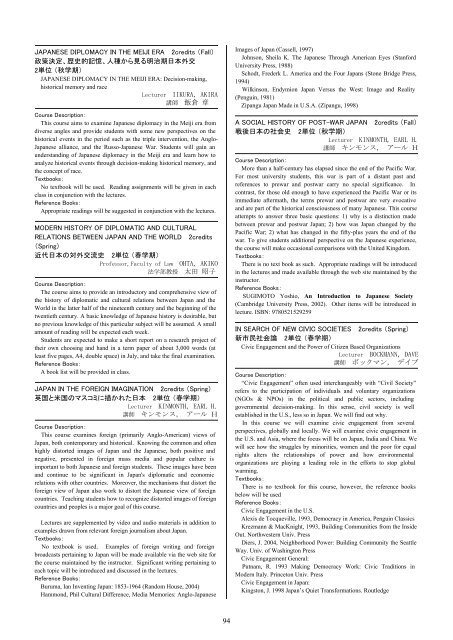

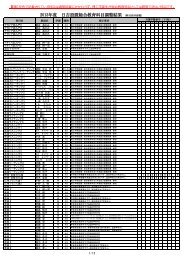
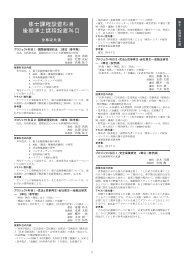
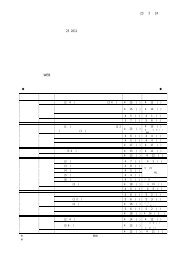
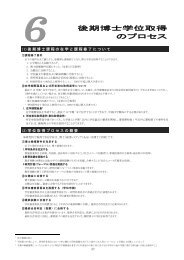
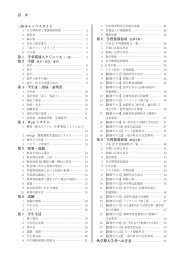



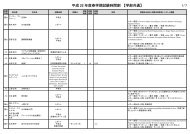

![文学部時間割表[2 ・3年生(07学則)]](https://img.yumpu.com/21046130/1/184x260/2-307.jpg?quality=85)

